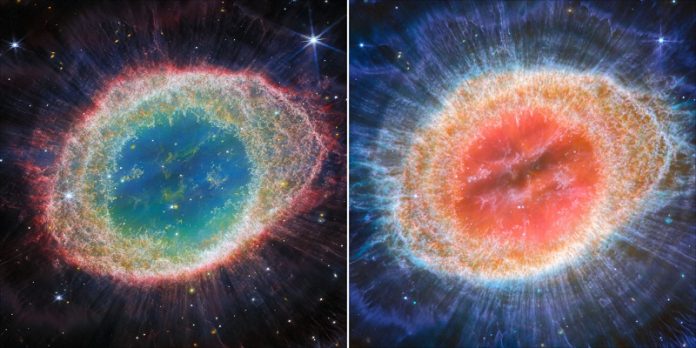
NASA’s James Webb Space Telescope has given us a new, detailed look at the Ring Nebula, a dying star’s colorful farewell 2,200 light-years away from us.
This telescope is much more powerful than the previous ones, like the Hubble, and has given us some surprising findings.
In the past, people thought these dying star clouds, also called planetary nebulae, were simple round shapes with just one fading star in the center.
We know these objects look like blurry planets when seen through small telescopes, which is why they got the name “planetary nebulae.”
However, the new images show something much more complex and interesting.
The Ring Nebula can be seen easily even with binoculars on a clear night. A team of scientists from around the world, named ESSENcE, specifically looked at this nebula.
They used two super-powerful cameras on the Webb telescope to take pictures of it. What they found surprised everyone.
First, the glowing ring in the middle of the nebula isn’t just a simple cloud; it’s made up of about 20,000 lumps of dense gas.
Each of these clumps is as heavy as our Earth! Inside this ring, they also found a rare kind of complex carbon molecule that usually isn’t found in places like this.
Then, outside the bright ring, there were odd ‘spikes’ that looked like they were pointing away from the middle star.
These spikes could only be seen clearly with the Webb telescope, not with older ones like the Hubble. Scientists think these spikes might be formed in the shadowy, protected areas behind the thick parts of the ring.
The most surprising part was the faint circle patterns they saw beyond the bright ring. These circle patterns were spaced in a way that suggests they formed about every 280 years.
This was puzzling because a lone dying star couldn’t do this by itself in that timeframe.
This led the scientists to think that there might be a second star, a companion to the dying one, shaping the patterns as it moves around it.
This second star would be roughly as far from the dying star as Pluto is from our Sun. No other telescope before was good enough to find this subtle clue.
So, how did a round star make such a complex nebula like the Ring Nebula? The new pictures and data hint that it might have had a little help from a companion star.
This finding could change the way we understand dying stars and the beautiful clouds they leave behind.
Follow us on Twitter for more articles about this topic.



